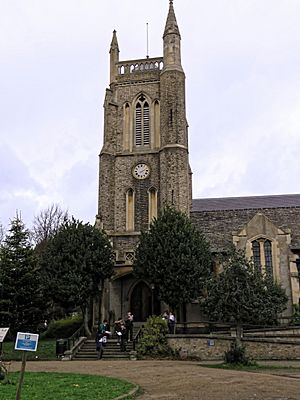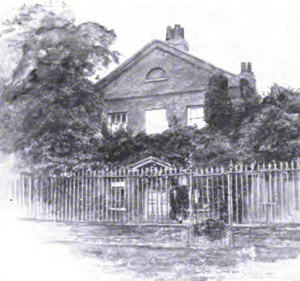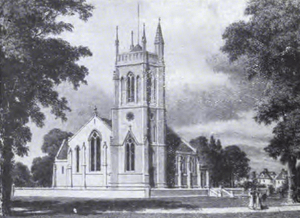St John the Baptist's Church, Leytonstone facts for kids
Quick facts for kids St John the Baptist's Church, Leytonstone |
|
|---|---|

View of south elevation of St John's Church
|
|
| Location | High Road, Leytonstone, London, E11 1HH |
| Country | England |
| Denomination | Church of England |
| Website | http://www.stjohns-leytonstone.org.uk/ |
| History | |
| Status | Active |
| Dedication | John the Baptist |
| Architecture | |
| Functional status | Parish church |
| Heritage designation | Grade II listed |
| Designated | 24 February 1987 |
| Years built | 1658-1932 |
| Administration | |
| Archdeaconry | West Ham |
| Diocese | Chelmsford |
The Church of St John the Baptist is a historic church in Leytonstone, East London. It's a Church of England parish church, meaning it serves the local community. You can find it on the High Road. This church is also a Grade II listed building, which means it's an important old building protected by law.
Contents
A Look Back: History of the Church
The First Church Building
Leytonstone was once part of the larger area of Leyton. The only church for Leytonstone residents was in Leyton. In 1748, some wealthy people in Leytonstone wanted a closer church. They felt it was too hard for many to travel to Leyton for worship.
So, they decided to build a "chapel of ease" in Leytonstone. This was a smaller church meant to make worship easier for people far from the main parish church. Even with some opposition, land was rented, and a small chapel was built. It opened in 1749.
The chapel was enlarged in 1819. It could seat 580 people. About 240 of these seats were free for those who couldn't pay. Because the land was rented, the chapel couldn't be officially "consecrated" (made sacred). However, the bishop allowed it to be used for church services.
After it was no longer used as a church, the building became a school. It was called the Leytonstone National Schools. The schools moved to a new building in 1876. The old chapel then became a place for meetings until it was taken down in 1938.
Building the New Church
In 1830, the vicar of Leyton spoke about how the old chapel wasn't good enough. He mentioned it was old, looked plain, and didn't have enough space. People then formed a group to raise money for a new church. A generous parishioner, Joseph Cotton, gave £1,000 to start.
An architect named Edward Blore was hired to design the new church. A large piece of land was bought further north on the High Road. This land was paid for by William Cotton, Joseph Cotton's son. The land was then given to the Church Commissioners in 1832.
The first stone of the new church was laid on July 20, 1832. The church was designed in the Early English Gothic style. It used yellow bricks with stone decorations. The original church had a small area around the altar, a main hall (nave), and a tall bell tower. It could seat about 600 people.
The church was officially made sacred on October 31, 1833. This was done by the Bishop of London. Later that year, the churchyard was surrounded by walls and railings. A set of six bells was made and given to the church. Each bell was named after a woman from the Cotton and Davis families. In 1845, St John's Church became its own separate parish.
Famous Visitors and Enlargements
The third vicar of St John's was Horace Waller. He was a strong supporter of ending slavery. He was friends with missionaries who traveled to Africa, like David Livingstone. After Livingstone passed away in 1873, his African companions, Abdullah Susi and James Chuma, came to England.
Waller invited them to stay at the vicarage in Leytonstone. There, they helped Waller prepare Livingstone's journals for publishing. In the vicarage garden, Susi and Chuma even built a copy of the African hut where Livingstone had died. A photo of this hut still exists today!
The railway came to Leytonstone in 1856. This brought many more people to the area. To make space for more churchgoers, several new churches were built nearby. These included Holy Trinity, St Andrew, St Margaret of Antioch, St Catherine, and St Columba.
St John's Church itself was also made bigger. Work started in 1893. New parts included a chancel for the choir and more seating. This added 140 new places. A new, large pipe organ was installed. It replaced an older organ that could play 66 hymns. A stone pulpit was also added. These additions were officially blessed in 1893. A larger room for the clergy was finished in 1902.
In 1902, the churchyard walls were moved for a road widening project. Trees were planted to celebrate the coronation of King Edward VII. In 1909, a new side aisle was added. This was made even longer in 1928 to create a side chapel. A ramp for wheelchairs was added in 2003.
St John's Church was given Grade II listed building status on February 24, 1987. This means it's a very important historic building.
St John's Church Today
Reverend David Britton became the vicar in July 2014.
Fun Events at the Church
St John's Church hosts many community events:
- The Stones Throw Market: Here, you can find local designs like jewelry, pottery, and homemade cakes.
- Churchyard Market: Another market held outside the church.
- Hitchcock Film Screenings: Outdoor movie nights in the churchyard, showing films by the famous director Alfred Hitchcock.
- Tower Tours: You can climb the church tower for amazing views across London. See landmarks like Canary Wharf and The Shard.
- Repair Cafe: This is a program where you can get bikes and electrical items fixed for free.
Bell Ringing at St John's
As of 2020, there was an active group of bell ringers at St John's. They ring the bells for Sunday services and practice on Monday evenings. A very famous former bell ringer was William Pye (1870-1935). He was known as "the greatest ringer of his time." Two new bells were bought for St John's to remember him. This made a total of eight bells in the tower.




